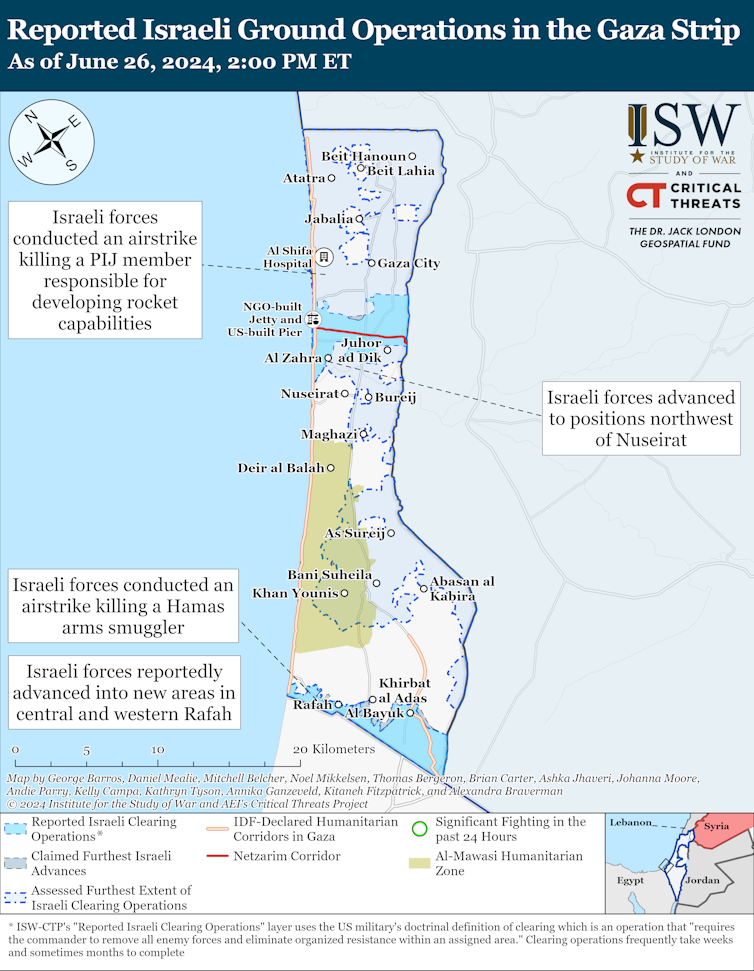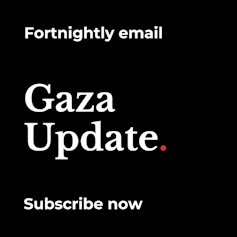Fighting continues in central and southern Gaza, as the Israel Defense Forces (IDF) continue to encounter resistance from units of Hamas fighters, despite a recent assessment by the Israeli government that the “intense phase” of the ground offensive is drawing to a close. The IDF will now switch to conducting raids, according to military sources posting on social media. This will mean keeping two divisions in Gaza.
One of the key operations that the IDF now envisages will be finding and destroying the remaining tunnels through which Hamas fighters continue to be supplied with arms and ammunition from Egypt. It is estimated this could take several months to achieve.
Meanwhile, speaking to Israeli television on June 23, Israel prime minister Benjamin Netanyahu said units would redeploy to Israel’s border with Lebanon to confront Hezbollah. Exchanges of fire with the Iran-backed militant group have become more and more intense in recent weeks.
But Netanyahu said this “doesn’t mean the war is about to end”. He stressed that fighting in Gaza would continue until Hamas was completely driven from power.

Scott Lucas, an expert in Middle East security at University College Dublin, says there are increasing indications of a difference of opinion between the prime minister and the IDF leadership. Speaking to a different television channel on June 19, a spokesman for the IDF, Rear Admiral Daniel Hagari said the aim of eradicating Gaza’s leadership was unattainable.
This business of destroying Hamas, making Hamas disappear – it’s simply throwing sand in the eyes of the public. Hamas is an idea, Hamas is a party. It’s rooted in the hearts of the people – anyone who thinks we can eliminate Hamas is wrong.
Lucas says the IDF subsequently rowed back on this position, releasing a statement insisting that Hagari had merely spoken about “eradicating Hamas as an ideology and an idea”. But with political tensions threatening the unity of the governing coalition and the increasingly intense conflict with Hezbollah brewing on Israel’s northern border and no sign of a workable ceasefire deal or the release of hostages, pressure on Netanyahu is mounting steadily.
Read more: Gaza war: Israeli military admits it can't win – but Benjamin Netanyahu isn't listening

Gaza Update is available as a fortnightly email newsletter. Click here to get our updates directly in your inbox.
The IDF could see its numbers boosted up up to 60,000 more young people, after Israel’s supreme court ruled that ultra-Orthodox Haredi Jewish men must be conscripted to do military service like every other young man and woman when they reach the age of 18. The exemption has existed as long as the state of Israel, writes John Strawson, an expert in Israeli politics who has addressed the key issues.
It’s a highly contentious issue and one that could crack Netanyahu’s shaky coalition wide open. As Strawson explains, ultra-Orthodox political parties have been part of almost every government for decades, wielding power out of all proportion to the roughly 13% of the population they represent. Two of those parties, Shas and United Torah Judaism (UTJ), have been crucial to keeping Israel’s longest-serving prime minister in power. And they are adamant that this judgment will not stand.
But Israel’s defence minister, Yoav Gallant, has made it clear that he agrees with the supreme court and will vote against any law that Netanyahu brings forward to counteract the judgment. Strawson says there’s now a big question mark over how long the two sides can remain in the same government, particularly given the intensity of feeling among Israel’s secular Jews, the vast majority of whom have long bitterly opposed the exemption.
Tensions on the Lebanon border
Meanwhile, if the intense phase of the Gaza conflict is coming to an end, there is an increasing intensity to the exchanges of fire between the Israel Defense Forces and Hezbollah over the border between Israel and Lebanon.
Most of the focus of this war has rightly been on the victims of the October 7 attack and the many, many Gazans killed or forced to flee their homes. Meanwhile more than 60,000 Israeli citizens in the north of the country have also been displaced, thousands of buildings destroyed or severely damaged and thousands of acres of orchards and forest burned. Some 28 Israeli civilians have been killed.
Michael Ben-Gad, an expert in economics and Israeli national security, sees the hand of Iran behind the escalation in Hezbollah violence. He explains that while Hamas is supported and funded by Iran, Hezbollah is pretty much an extension of Iran’s Revolutionary Guard. Hezbollah’s leader, Hassan Nasrallah, is effectively Iran’s proconsul in the Levant.
The last time Israel and Hezbollah went to war was in 2006, a conflict which was brought to an end by UN security council resolution 1701, under which Hezbollah agreed to disarm and give way to the regular Lebanese army. None of this happened, but the two sides have avoided an all-out conflict since.

Ben-Gad is concerned that “the calculus in Tehran now appears to have changed”. With the US looking to disengage from the Middle East and focus more directly on the Pacific, Iran has reactivated its nuclear programme. Hezbollah meanwhile, presumably with the backing of Iran, is talking of targeting Haifa, Israel’s third-largest city and biggest port. An attack on Haifa would mean all-out war – a conflict in which there would arguably only be one winner: Iran.
Read more: Only Iran can benefit from the coming war between Israel and Hezbollah
An all-out conflict with Hezbollah would effectively mean Israel would be fighting a war on two – maybe even three – fronts. As we have seen, there is realistically no end in sight to the military operation in Gaza which is costly both in terms of soldiers and arms and ammunition. But there is also the possibility that unrest in the West Bank, where violence is beginning to spiral out of control, could erupt into a full-scale intifada. The presence on the West Bank of an estimated 700,000 illegal settlers means IDF resources are tied up protecting them.
Simon Mabon, who specialises in Middle East security at Lancaster University, thinks Israel is currently ill-equipped to take on Hezbollah as well. While Israel can still count of the support of Washington, with Joe Biden facing a tight re-election campaign, he is under pressure to calm things down. And a fresh conflict engulfing Lebanon is not something the White House would view with any relish. Mabon addresses the key issues here.
Read more: What would war between Israel and Hezbollah mean for the Middle East? Expert Q&A
Gaza Update is available as a fortnightly email newsletter. Click here to get our updates directly in your inbox.

